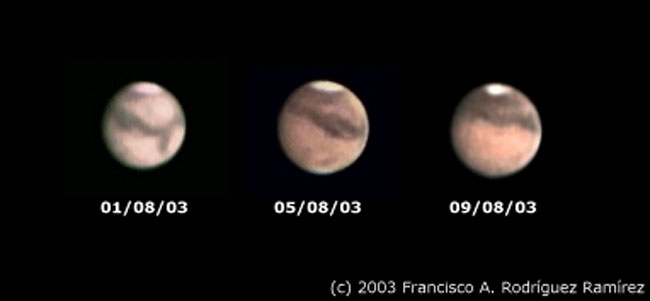
|
Credit: Francisco A. Rodriguez Ramirez
(AstroEduca)
Explanation:
How does Mars appear through a small telescope?
Viewed with the unaided
eye or through a small telescope, possibly the most striking part of
Mars' appearance is it's red color.
The color derives from
rust, iron oxide, which composes perhaps 10% of the
Martian soil.
The oxygen that rusts the surface iron on Mars originates
predominantly from
carbon dioxide gas, which composes 95% of the
Martian atmosphere.
Mars nears its closest approach with Earth in nearly 60 millennia on August 27,
the red planet continues to appear larger,
brighter, and a good target for
sky enthusiasts.
Pictured above,
Mars was captured from the
Canary Islands of
Spain during three days in three different orientations
earlier this month.
Visible through the small telescope are white
polar caps of water and carbon-dioxide ice,
light red areas rich in lightly colored craters, and dark red
areas dominated by relatively smooth lowlands.
|
January February March April May June July August September October November December |
| ||||||||||||||||||||||||||||||||||||||||||||||||
NASA Web Site Statements, Warnings, and Disclaimers
NASA Official: Jay Norris. Specific rights apply.
A service of: LHEA at NASA / GSFC
& Michigan Tech. U.
Based on Astronomy Picture
Of the Day
Publications with keywords: Mars
Publications with words: Mars
See also:
